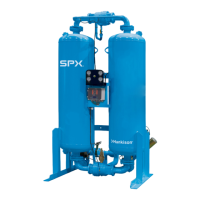
Do you have a question about the SPX Hankinson HHE Series and is the answer not in the manual?
| Category | Dryer |
|---|---|
| Manufacturer | SPX Hankinson |
| Model | HHE Series |
| Desiccant | Activated Alumina |
| Pressure Dew Point | -40°F (-40°C) |
| Dew Point | -40°F (-40°C) |
| Inlet Temperature | 100°F (38°C) |
| Type | Heatless |
| Pressure Rating | 150 PSIG (10.3 BAR) |
| Power Supply | 115V/1ph/60Hz |
| Materials | Carbon Steel |
Safety guidelines for pressure-containing equipment operation and maintenance.
Safety measures for electrical components, installation, and service work.
Notes on breathing air quality suitability and noise level cautions.
Instructions for receiving shipments and checking for visible damage.
Procedures for moving, unpacking, and handling concealed damage claims.
Explains the dual-tower regenerative desiccant dryer mechanism.
Describes the APS system's energy-saving function and operation.
Describes the air drying and regeneration process for these models.
Describes the air drying and regeneration process for these models.
Describes the air drying and regeneration process for these models.
Explains how the APS system monitors and adjusts drying cycles.
Guidance on choosing the optimal installation location for the dryer.
Requirements for aftercoolers, receivers, prefilters, and afterfilters.
Specifies space and access needs for dryer installation.
Defines operating parameter limits and maximum pressure.
Specifies the minimum operating pressure requirements for operation.
Defines the maximum allowable inlet air temperature.
Specifies the minimum and maximum ambient operating temperatures.
Instructions for mounting the dryer and connecting piping.
Guidance on using isolation valves and making electrical connections.
Information on purge exhaust management and initial desiccant.
Explains the meaning of various icons on the control panel.
Provides a general overview of the available dryer controller types.
Lists relevant figures for the Timer Based Controller.
Details for connecting the Timer Based Controller.
Lists relevant figures for the Level 1 Controller.
Details for connecting the Level 1 Controller.
Explains AC and DC input power connection procedures.
Details for connecting common alarm contacts.
Information on connecting remote start/stop controls.
Information on connecting remote switches.
Jumper setting for maximum operating pressure.
Jumper setting for common alarm logic.
Jumper setting for service reminder intervals.
Jumper setting for power recovery mode selection.
Explanation of the function of each front panel LED.
Explains the function of front panel switches.
Details how switching failure alarms are indicated and handled.
Provides fixed cycle timing information for the Level 1 Controller.
Describes event sequences and component status for the Level 1 Controller.
Lists relevant figures for the Level 2 Controller.
Details for connecting the Level 2 Controller.
Explains AC and DC input power connection procedures.
Details for connecting common alarm contacts.
Information on connecting remote start/stop controls.
Information on connecting remote switches.
Jumper setting for maximum operating pressure.
Jumper setting for electric drains.
Jumper setting for common alarm logic.
Explanation of the function of each Level 2 front panel LED.
Explains the function of Level 2 front panel switches.
Explains the function of the dryer on/off switch.
Explains the function of the SELECT switch.
Explains the function of the ENTER switch.
Explains the function of the alarm reset switch.
Describes event sequences and component status for the Level 2 Controller.
Details on entering and using Program Mode.
Details on entering and using Setup Mode.
Screen for selecting the dew point class.
Screen for selecting the cycle type (Demand, Fixed, Manual).
Screen for testing the electric drains.
Details of various alarm messages displayed by the controller.
Describes alarms triggered by pressure switch faults.
Describes alarms triggered by thermistor faults.
Describes alarms for optional devices like electric drains.
Details the message for filter service.
Details the message for desiccant service.
Details the message for valve service.
Screen showing current dew point class and cycle type.
Screen showing the selected energy savings percentage.
Displays for service reminders and valve cycle count.
Screens for performing test mode operations for each step.
Screens displayed when attempting to exit test mode.
Step-by-step instructions for starting the dryer.
Ensuring controller settings are correct for start-up.
The process of initially pressurizing the dryer system.
How to safely apply power to the dryer.
Procedure for setting the correct purge rate for optimal performance.
Steps to transition from start-up to normal operation.
Procedure for readjusting purge rate after initial setup.
Routine checks to ensure proper dryer operation.
Checking power status and moisture indicator readings.
Verifying purge pressure settings and checking for alarms.
Monitoring tower status LEDs and pressure gauges.
Inspecting mufflers and verifying process valve operation.
Details on valve operation for specific models.
Details on valve operation for specific models.
Method for calculating maximum inlet flow capacity.
Information and calculations for purge and outlet air flows.
Method to calculate maximum purge flow.
Method to calculate average purge flow.
Method to calculate minimum outlet air flow.
Method to calculate average outlet air flow.
A practical example of flow calculations.
Procedures for replacing the desiccant material.
Guidance on when desiccant replacement is needed.
Step-by-step instructions for desiccant replacement.
Tips for maintaining desiccant dryness.
Recommended maintenance for purge mufflers.
Procedures for checking valve operation and leaks.
Procedure for replacing the pilot air filter element.
Guidance on when to replace the pilot air filter.
Step-by-step instructions for replacing the filter element.
Replacement procedure specific to models 40-3000.
Replacement procedure specific to models 4100-5400.
Troubleshooting steps for when indicator lights are off.
Troubleshooting steps for a yellow moisture indicator.
Troubleshooting premature saturation of the desiccant beds.
Troubleshooting steps when a tower fails to repressurize.
Troubleshooting excessive purge air discharge.
Troubleshooting issues related to desiccant dust.
Troubleshooting switching failure alarms in controllers.
Table for recording dryer serial number tag information.
